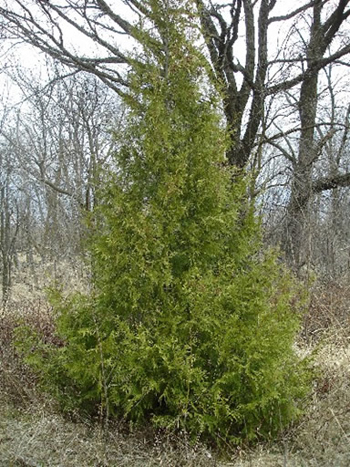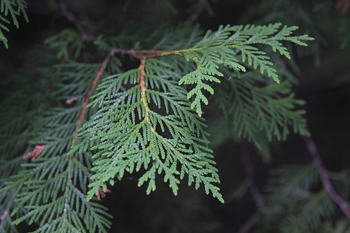Contents:
Common Names | Parts Usually Used | Plant(s) & Culture | Where Found | Medicinal Properties
Legends, Myths and Stories | Uses | How Sold | Warning | Bibliography
Scientific Names

- Thuja occidentalis L.
- Arborvitae
- Biotae orientalis
- Cupressaceae
- Pinaceae
Common Names
- Arbor-vitae
- False white cedar
- Thuja
- Tree of life
- Yellow cedar
Parts Usually Used
Leaves, inner bark, leaf oil and seeds.
Back to Top
Description of Plant(s) and Culture

Although a slow grower, Thuja is a well-known ornamental American evergreen; it can reach 70-80 feet, retaining its dense, pyramidal form. Some say the northern white cedar is of the cypress family, some references say it is of the pine family. This hardy evergreen has dense, scale-like foliage, waxy to the touch, and fragrant. Leaves in flattened sprays; small, appressed overlapping. Cones bell-shaped, with loose scales.
Back to Top
Where Found
A native of the U.S. and Canada, this tree does best in moist, sandy loam. In a dry situation, it will suffer from both heat and cold. Found in swamps; cool rocky woods. Most nurseries stock several varieties. Found growing in the wet ground from New Hampshire to Florida.
Back to Top
Medicinal Properties
Stimulant, astringent, vermifuge, anti-inflammatory, antimicrobial, diuretic, emmenogogue, expectorant, anthelmintic, irritant
Experimentally, leaf oil is antiseptic, expectorant, counterirritant; extracts have shown antiviral properties against herpes simplex.
Back to Top
Legends, Myths and Stories
Native Americans put boughs of cedar on teepee poles, said to ward off lightning. Thunderbird was said to nest in mountain cedars. Red cedar (J. scopulorum), used ceremonially on the altar of the sacred woman at the Sun Dance.
Back to Top
Uses
The leaves and tops of Northern White Cedar are used for chronic cough, fever, and gout. An infusion made of 1 oz. of the tender leaves to a pint of boiling water may be taken 1 tbsp. at a time as a diuretic, emmenogogue, and uterine stimulant. Applied externally, it is said to remove warts and fungoid growths. As a counterirritant, it is useful for relief of muscular aches and pains. A salve for external application can be made by boiling a quantity of the leaves in lard.
The oil has been used as an aromatic ingredient in soap liniment. And the odor of the essential oil is pungent, almost overpowering. It is matched by a strong bitter taste. Arborvitae oil may be home distilled and used as an insect repellent.
American Indians used leaf tea for headaches, colds, in cough syrups, in steam baths for rheumatism, arthritis, congestion, and gout; externally, as a wash for swollen feet and burns. Inner-bark tea used for consumption. Doctors once used leaf tincture externally on warts, venereal warts, gonorrhea, syphilis, prostate problems, toothache, whooping cough, piles, ulcers, bed sores, and fungus infections. Internally, leaf tincture was used for bronchitis, asthma, pulmonary disease, enlarged prostate with urinary incontinence.
Folk medicine cancer remedy.
Back to Top
How Sold
Tincture
Back to Top
Warning
Taken in excess, the oil can produce unpleasant results; it was officially listed as an abortifacient (a drug or agent causing abortion) and convulsant in overdose.
Leaf oil is considered toxic, causing hypotension (low blood pressure), and convulsions. Fatalities have been reported.
Do Not use this herb during pregnancy.
Do Not use without medical supervision.
Back to Top
Bibliography
![]() Eastern/Central Medicinal Plants
Eastern/Central Medicinal Plants, by Steven Foster and James A. Duke., Houghton Mifflin Company, 215 Park Avenue South, New York, NY 10000
![]() The Complete Medicinal Herbal
The Complete Medicinal Herbal, by Penelope Ody, Dorling Kindersley, Inc, 232 Madison Avenue, New York, NY 10016, First American Edition, copyright 1993
![]() Webster’s New World Dictionary
Webster’s New World Dictionary, Third College Edition, Victoria Neufeldt, Editor in Chief, New World Dictionaries: A Division of Simon & Schuster, Inc., 15 Columbus Circle, New York, NY 10023
![]() Planetary Herbology
Planetary Herbology, by Michael Tierra, C.A., N.D., O.M.D., Lotus Press, PO Box 325, Twin Lakes. WI 53181., Copyright 1988, published 1992
![]() Indian Herbalogy of North America
Indian Herbalogy of North America, by Alma R. Hutchens, Shambala Publications, Inc., Horticultural Hall, 300 Massachusetts Avenue, Boston, Massachusetts 02115, 1973
 How Indians Use Wild Plants for Food, Medicine & Crafts
How Indians Use Wild Plants for Food, Medicine & Crafts, by Frances Densmore, Dover Publications, Inc., 180 Varick Street, New York, NY 10014, first printed by the United States Government Printing Office, Washington, in 1928, this Dover edition 1974
![]() The Herbalist Almanac
The Herbalist Almanac, by Clarence Meyer, Meyerbooks, publisher, PO Box 427, Glenwood, Illinois 60425, copyright 1988, fifth printing, 1994
![]() Indian Uses of Native Plants
Indian Uses of Native Plants, by Edith Van Allen Murphey, Meyerbooks, publisher, PO Box 427, Glenwood, Illinois 60425, copyright 1958, print 1990
 The Rodale Herb Book: How to Use, Grow, and Buy Nature’s Miracle Plants (An Organic gardening and farming book)
The Rodale Herb Book: How to Use, Grow, and Buy Nature’s Miracle Plants (An Organic gardening and farming book), edited by William H. Hylton, Rodale Press, Inc. Emmaus, PA, 18049., 1974
